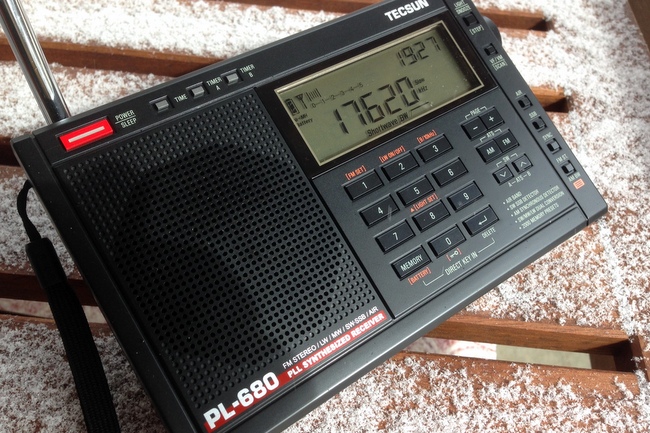 When I heard early reports about the new Tecsun PL-680, I was already wondering how it would stack up alongside other Tecsun portables. An early photo of the Tecsun PL-680 revealed how very similar it is, indeed, to the Tecsun PL-600, which has been on the market for many years. Moreover, the features of PL-680, which I heard about only a few weeks ago, sounded to me like a carbon copy of the venerable PL-660. I investigated further, and spoke with Anna at Anon-Co; she was given to understand that the Tecsun PL-680 was essentially a re-packaged PL-660 with improved sensitivity. I was curious enough about the PL-680 that I ordered one from Anna as soon as they were available, even paying for expedited shipping in order to have it in hand a bit sooner.
When I heard early reports about the new Tecsun PL-680, I was already wondering how it would stack up alongside other Tecsun portables. An early photo of the Tecsun PL-680 revealed how very similar it is, indeed, to the Tecsun PL-600, which has been on the market for many years. Moreover, the features of PL-680, which I heard about only a few weeks ago, sounded to me like a carbon copy of the venerable PL-660. I investigated further, and spoke with Anna at Anon-Co; she was given to understand that the Tecsun PL-680 was essentially a re-packaged PL-660 with improved sensitivity. I was curious enough about the PL-680 that I ordered one from Anna as soon as they were available, even paying for expedited shipping in order to have it in hand a bit sooner.
The Tecsun PL-660 has been on the market for several years now; it’s one of the most popular shortwave portables on the market. And for good reason: the PL-660 is relatively inexpensive, simple to use, packs all of the most vital and desirable functions/modes, and is available from a variety of retailers that ship worldwide. I have reviewed it numerous times and often used it as the basis for comparison with other shortwave portables. It’s China-based manufacturer, Tecsun, has emerged over the past few years as the dominant manufacturer of shortwave radios.
First impressions
I posted a few unboxing photos the day I received the PL-680.
The Tecsun PL-680 looks like the Tecsun PL-600 body, with the Tecsun PL-660 features and layout. Indeed, the full complement of buttons, switches and dials are identically positioned to those of the PL-660.
Let’s cut to the chase…
Question: So, does the PL-680 have more functions than the PL-660?
Answer: No. It appears to be, and likely is, identical in every (functional) respect to the Tecsun PL-660. No surprises here, unless there are hidden features I haven’t discovered…!
Check out the following comparison photos–the PL-600 on the right, PL-660 in the middle, PL-680 on the right (click to enlarge):
The similarity is so striking, in fact, that I believe the PL-680 is the first radio I’ve ever turned on for the first time, only to find I immediately knew every function. I’m so familiar with the PL-660 that I could even use the PL-680 in the dark the first night I used it.
It also helps, of course, that the PL-680 is nearly identical to the PL-600, too, which I’ve owned for many years.
Here’s how I see the PL-680 product development equation:
In truth, I was quite disappointed that Tecsun did not add a line-out jack to the PL-680.
The PL-660, alas, lacks line-out, and though my Tecsun PL-880 has a line-out, its default shortwave volume is simply too high to be used by most digital recorders. I had hoped that the PL-680 might have a proper line-out jack, potentially making it a replacement for my trusty Sony ICF-SW7600GR. Unfortunately, this is not the case.
But other than missing a line-out jack, I really have few complaints. I’ve always been a fan of simple radio design and I believe Tecsun has done a good thing by keeping the user experience so similar in their PL-6XX line of portable shortwave radios. Apparently, a good thing is a good thing.
But here’s what everyone wants to know…
Question: Does the PL-680 have any performance advantages over the PL-660?
Short Answer: Yes! (But keep your PL-660.)
I should add here that I’m about to get rather technical and radio-geeky, so if you’re only interested in a summary, please skip to the bottom of the page.
Otherwise, help yourself to a cup of coffee, and let’s talk radio…
Shortwave performance
Since I spend 95% of my listening time on shortwave, I’ll begin with shortwave performance. Again, we’ll compare the PL-680’s performance with that of the PL-660.
Reader survey results
Having had such great results from radio comparison shoot-outs in the past (check out our shoot-out between top portables and ultra-compact radios), I decided it would make sense to invite our informed readership to evaluate the PL-680’s performance in a series of blind, informal tests. (For information about these surveys, please read through the first of the three surveys.)
Shortwave AM broadcast listening
In most circumstances, you’ll find that the PL-680 has better sensitivity than the PL-660. It’s a marginal improvement, but one I certainly notice on the shortwave bands–and so did the majority of readers who participated in the shortwave AM reception survey.
The survey had recordings from a total of three broadcasters: Radio Prague, WWV, and Radio France International.
The PL-680 was “Radio A,” and the PL-660 was “Radio B.”
The Radio Prague recording was quite strong and was the only broadcast in our survey in which the PL-660 and PL-680 ran neck-and-neck.
In truth, I believe strong signal reception on both these radios is excellent and nearly indistinguishable from each other.
Survey results from the WWV and Radio France International recordings showed a strong preference for the Tecsun PL-680. Again, here are the original recordings:
Based on comments from those who participated, the PL-680 came out ahead of the PL-660 in two respects: better sensitivity, and more stable AGC. In both sets of recordings, the signal was weaker than the Radio Prague recording, and QSB (fading) more pronounced. Herein lies a well-known weakness of the PL-660: soft muting and a sometimes over-active AGC equates to more listening fatigue.
Here is a chart with the full survey results based on 194 listener reports. The number of responses are represented on the vertical axis.
Obviously, the engineers at Tecun addressed the soft muting/AGC problem of the PL-660. In all of my time with the PL-680 on the air, I haven’t noticed any soft muting; the audio has been smooth and the AGC copes with fading much better than the PL-660. No doubt, these two improvements alone make the PL-680 a worthy portable for shortwave radio listening.
There is a downside to the improved sensitivity, however: the PL-680 has a slightly higher noise floor than the PL-660. This is mostly noticeable during weak-signal listening. Though I haven’t compared it yet, I’m willing to bet that the noise floor is comparable to that of the Sony ICF-SW7600GR. Personally, if increased sensitivity and stability means a slightly higher noise floor, I’m okay with that. I find that I listen better when the signal is stable and not fluttering/muting with every QSB trough.
Synchronous detection
The second survey focused on synchronous detection, which is a very useful receiver tool that mitigates adjacent signal interference and improves a signal’s stability. Perhaps it was my good fortune that the same day I tested synchronous detection, fading on even strong stations was pronounced at times. Perfect!
The first recording set was from Radio Australia, a relatively strong signal here in North America. Still, QSB was pronounced–making for an unstable signal–and there was hetrodyne interference in the upper sideband of the broadcast. When I switched the radios into lower sideband sync, halfway through, it effectively mitigated the hetrodyne in all of the recordings.
PL-680 – 1st recording Radio Australia
PL-660 – 1st recording Radio Australia
PL-680 – 2nd recording Radio Australia
PL-660 – 2nd recording Radio Australia
The second set of recordings were of Radio Riyadh–a much weaker station–also affected by QSB:
PL-680 – 1st recording Radio Riyadh (wide band filter)
PL-660 – 1st recording Radio Riyadh (wide band filter)
PL-680 – 2nd recording Radio Riyadh (narrow band filter)
PL-660 – 2nd recording Radio Riyadh (narrow band filter)
While I have always considered the PL-660 to sport one of the stronger sync locks in current production portables, it did truly struggle to maintain a lock in both the Radio Australia and Radio Riyadh recordings. Indeed, I was so surprised by how comparatively feeble the sync lock was on Radio Australia, that I disconnected the PL-660 from the recorder and moved to a different location to verify that something nearby wasn’t causing the sync lock instability. It was not; it was solely due to unstable band conditions.
It came as no surprise that survey respondents took note of the PL-680’s stronger sync lock: the PL-680 beat the PL-660 by a wide margin in both sample recordings. I chart the results, below, from a total of 85 responses:
Very good, PL-680! Someday I’d like to compare the PL-680 with the Sony ICF-SW7600GR, which I’ve always considered to have, among current portables, the strongest sync lock.
Single Sideband
I wasn’t able to provide an audio survey of SSB performance since the PL-680 picked up too much noise from my digital recorder to make for a fair contest.
Meanwhile, I’ve spent time listening to both radios in SSB mode and comparing the models. To my ear, both are very close in SSB performance, but again the PL-680 does have a slight edge on the PL-660 in terms of sensitivity and AGC performance.
SSB audio fidelity is very similar in both radios.
FM Performance
While I haven’t spent more than, let’s say, an hour with the PL-680 on the FM band, I have concluded that it is very sensitive–able to receive all of my benchmark local and regional FM stations.
An informal comparison between thePL-680 and the PL-660 also leads me to believe that they are both excellent FM performers and seemed to compare favorably. I would certainly welcome FM DXers to comment with their own evaluations of the PL-680.
Medium Wave Performance
I’ve also posted a medium-wave listener survey since many of you asked that I provide an evaluation of the medium-wave band.
In short, here is where the PL-680 loses to the PL-660: whereas, on the shortwave bands, the PL-680 is more sensitive, it lacks the same sensitivity on the medium-wave bands.
Though I believe the PL-680 does a marginally better job than the PL-660 of handling the choppy conditions of nighttime MW DX, the PL-660 still pulled voices and music out of the static and made them noticeably more intelligible.
The survey result swung very hard in favor of the PL-660, which has long been one of the more notable medium-wave performers among shortwave portables.
I provided a total of four sample broadcast recordings for comparison. Below, I have embedded one of them–a recording of 940 AM in Macon, Georgia, for your reference.
You can listen to all four recordings in the original survey (again, note that Radio A is the PL-680, B is the PL-660).
Survey results were definitive, with a total of 116 responses:
In all but the strong station sample (750 AM – WBS Atlanta), the PL-660 was preferred by a wide margin.
Summary
Invariably, all radios have strengths and weaknesses; here is a list of my notes from the moment I put the Tecsun PL-680 on the air:
Pros:
- Excellent sensitivity and selectivity on the shortwave bands
- Improved weak signal stability over the PL-660
- Stable sync lock
- Proven PL-600 form factor with good overall ergonomics
- Great internal speaker–an improvement over the PL-660 (but not as good as the PL-880 or Sangean ATS-909X)
- Other than medium-wave performance (see con), a worthy replacement for the PL-660
- Excellent audio from the PL-680 internal speaker (improved over the PL-660, but not matching the fidelity of the PL-880)
Cons:
- Medium-wave performance for is a step backwards from the PL-680’s predecessor, the PL-660. Okay on strong and moderate-signal reception, somewhat poor for weak signals
- Marginal noise floor increase on the shortwave bands
- Like the PL-660, lacks a line-out jack (Please note this, Tecsun!)
- SSB frequency display on my unit is + 1 kHz, slight BFO adjustment is needed (details in this update)
Conclusion
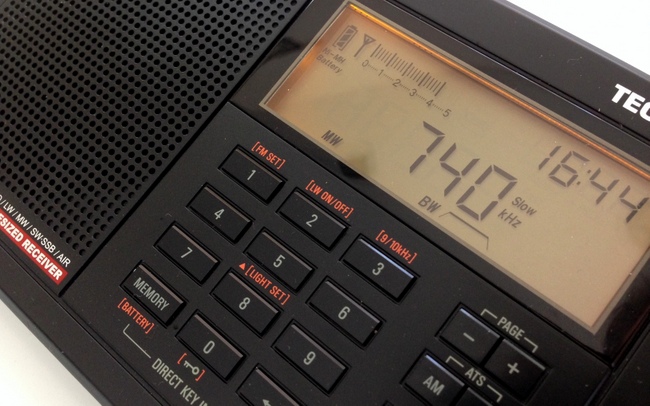 If you’re a shortwave radio listener, you’ll be pleased with the Tecsun PL-680. In all of my comparison tests between the Tecun PL-660 and Tecsun PL-680, the PL-680 tends to edge out the PL-660, performance-wise. This coincides with the user surveys, too.
If you’re a shortwave radio listener, you’ll be pleased with the Tecsun PL-680. In all of my comparison tests between the Tecun PL-660 and Tecsun PL-680, the PL-680 tends to edge out the PL-660, performance-wise. This coincides with the user surveys, too.
If you’re a medium-wave DXer, you might skip over the PL-680. That is, unless Tecsun makes a good iterative design improvement. If you’re a casual medium-wave listener, on the other hand, you’ll probably be pleased with the PL-680.
All in all, I like the Tecsun PL-680 and I see myself using it more than the PL-660 when I’m on the go. If you’re primarily a shortwave radio listener, the PL-680 may very well be worth the upgrade. At $95 US plus shipping, it is certainly a good value. Note that Anon-Co plans to post the Tecsun PL-680 for sale on eBay in March 2015.
Click here to find the PL-680 on eBay.
Addendum:
- PL-680 calibration: Dennis Coomans confirms via Anon-Co that the PL-680 (like the PL-660) can be calibrated by long pressing the AIR button (for SW, AM, etc) and by pressing SYNC for FM. According to Anon-Co, “all PL-680 receivers from production lines after November 2017 have this (hidden) manual calibration feature.”

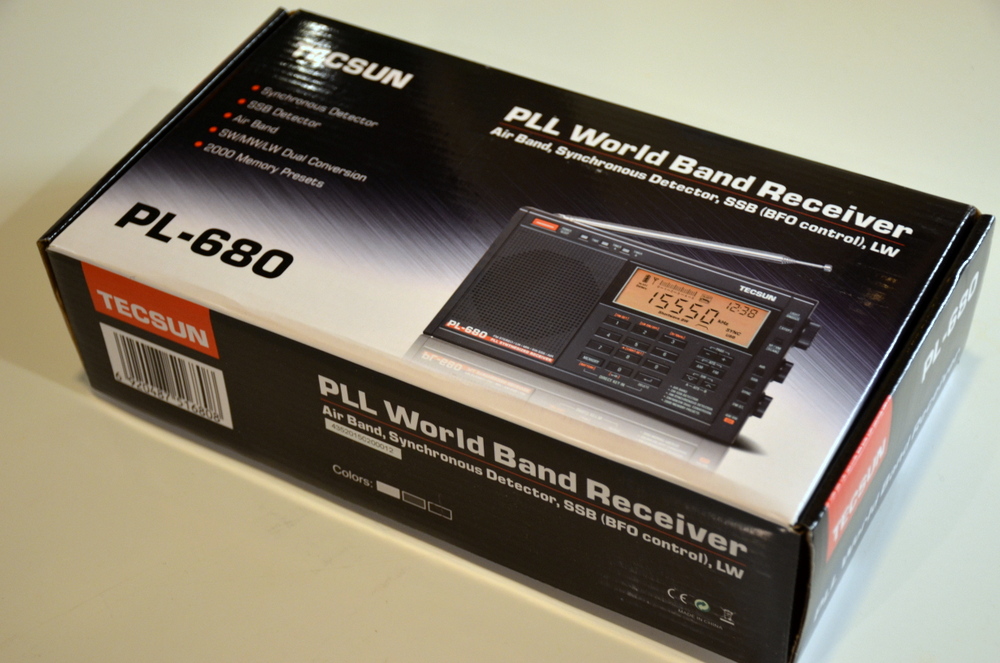

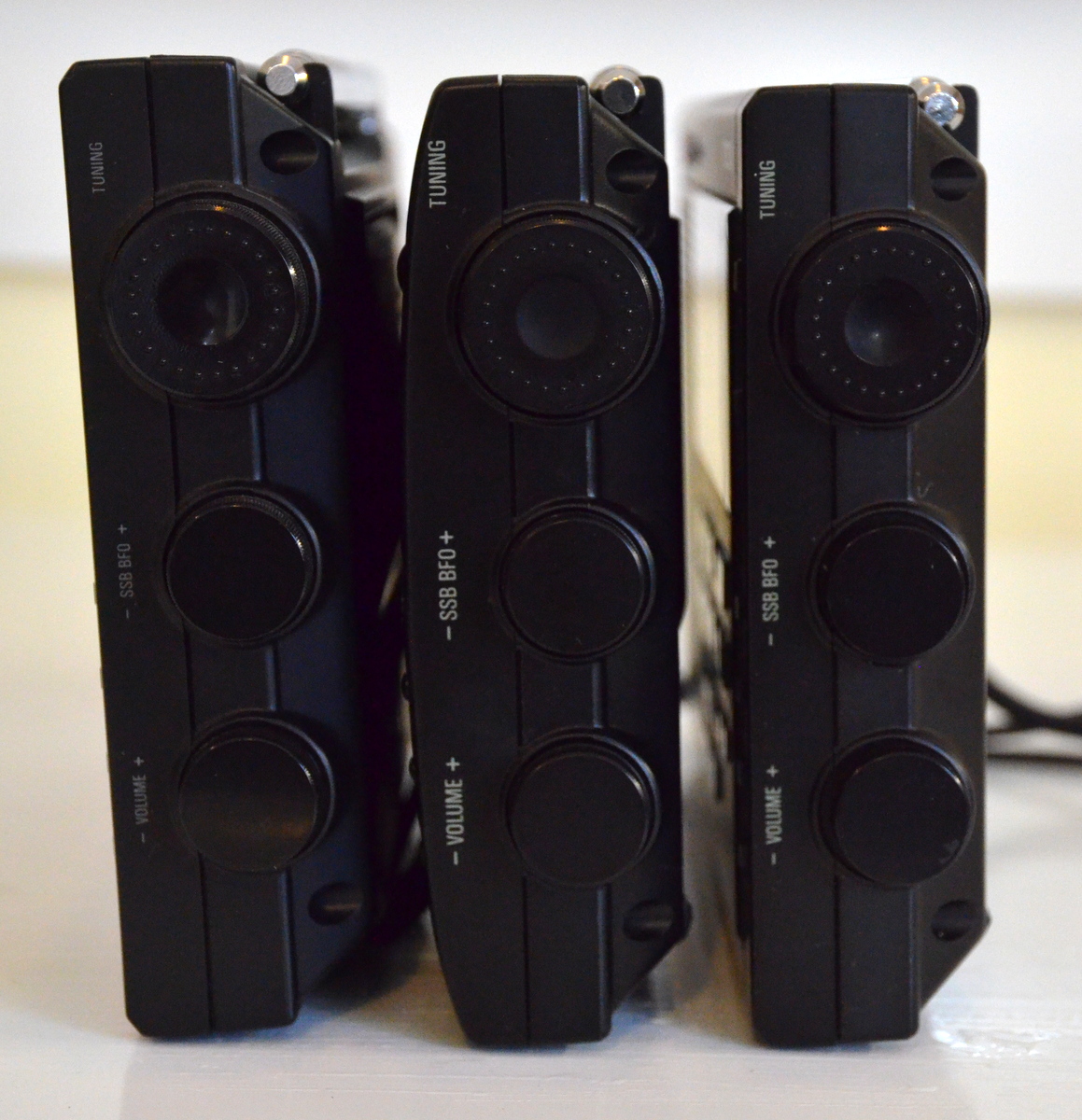
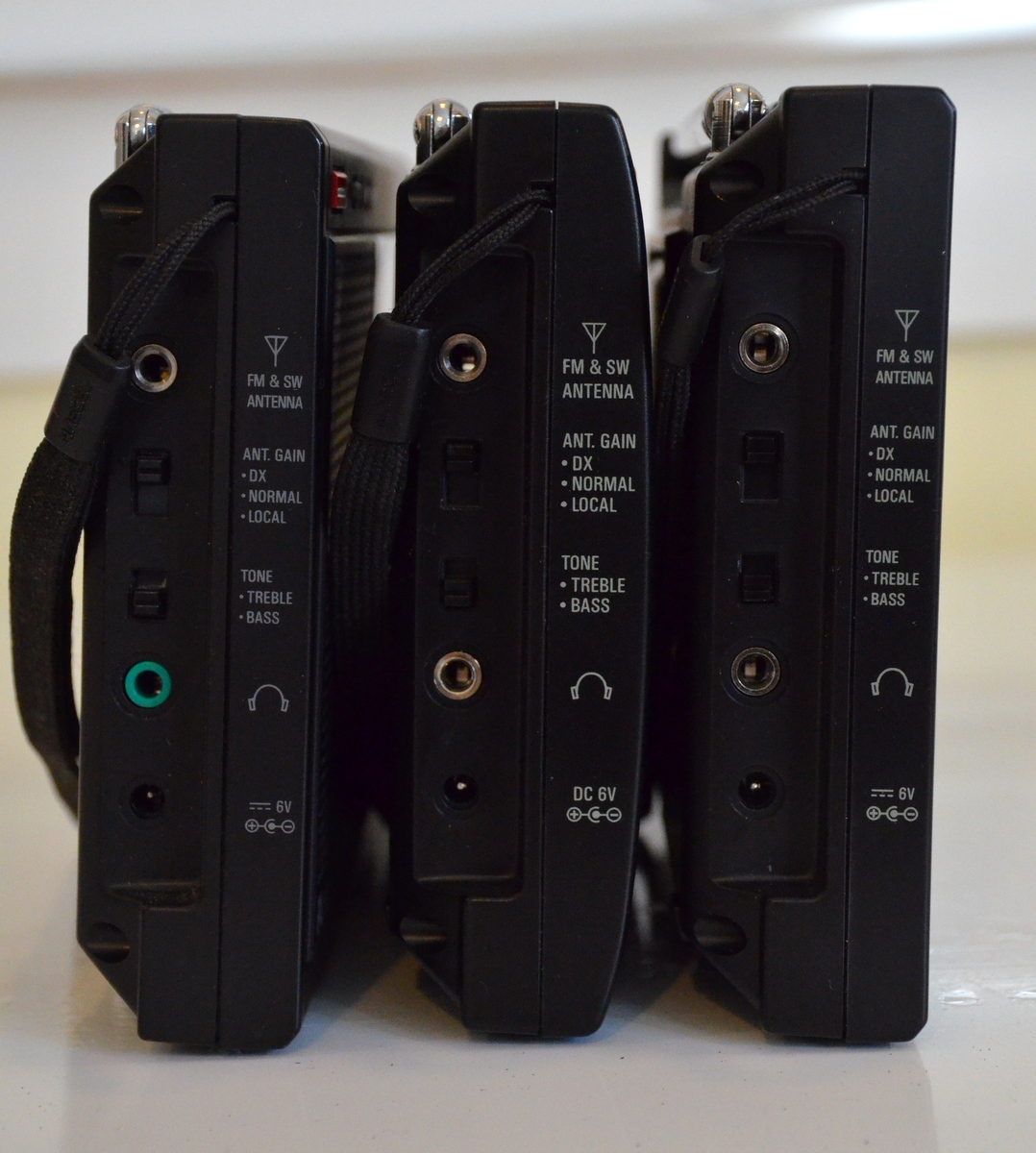
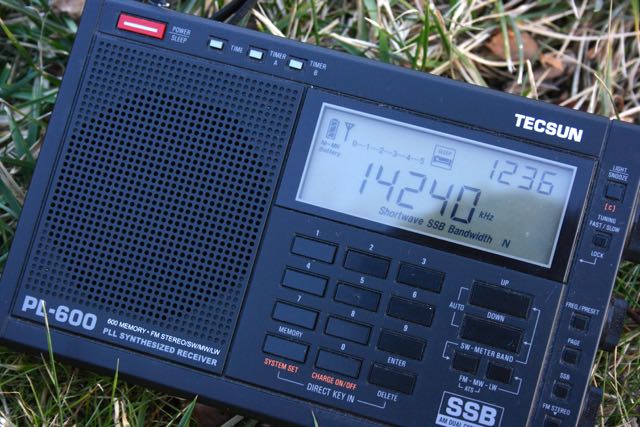

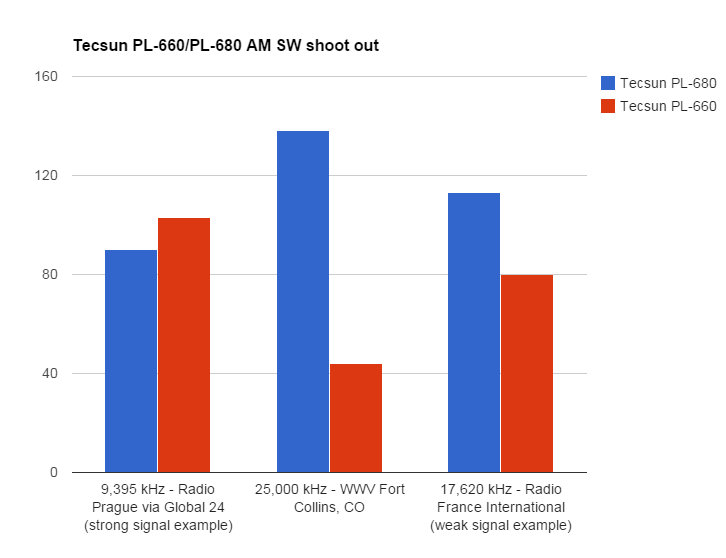
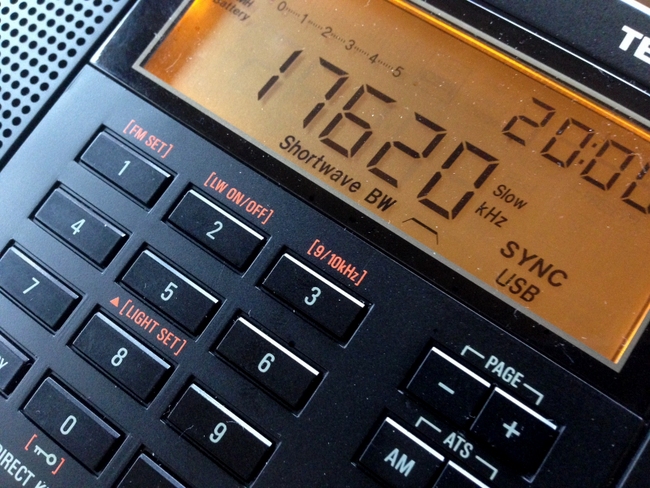
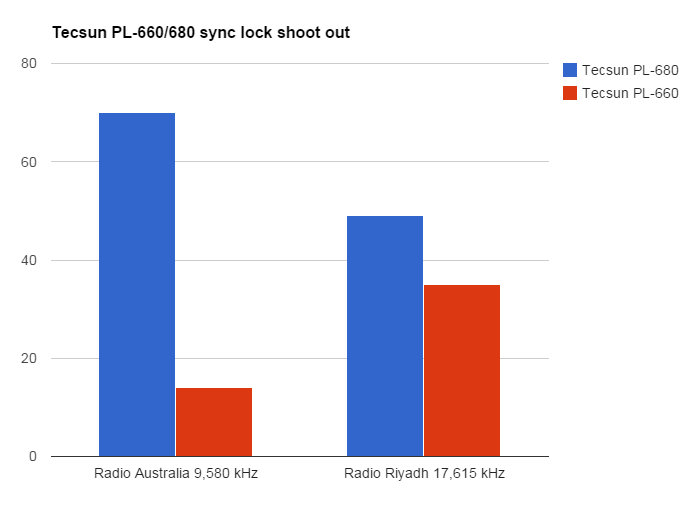

Thomas —
i will contact Valdo this weekend. Thankyou.
— gary
Hi Gary wow that was expensive I bought mine in 2005, used in awesome conditions 280.00 I think. I decided now to buy the PL-680, I did, I am waiting for it. Per what you say seems to be a good radio, so I will give it a try.
Dave —
i paid $350 back then. My fellow economists at the Dept. of Labor helpfully offer a “CPI calculator” here: https://www.bls.gov/data/inflation_calculator.htm.
Your $280 in 2005 is a bit under $400 today. That said i would not have traded my $750 (today’s value) for being able to listen to the end of the Cold War on my Sony 2010 that i bought in the late 1980s. It was gripping indeed, particularly for this long-term Pentagon employee.
— gary
Interesting read and I find it rather surprising that MW performance on the PL-660 is better than that on the PL-680. I live in Ireland and the PL-660 can hardly hear any UK MW stations at night where as the PL-680 hears tonnes of MW stations from Spain and the U.K at night.
I can also pick up BBC R4 LW on the PL-680 and a French and I think Polish LW station on the 680 and can’t hear them at all on the PL-660 so to me the 660 is practically deaf on LW/MW.
I really love the PL-680, I had the PL-880 and S-8800 and sold them because they have a higher noise floor and extremely poor performing SSB and lack of SYNC detection but also zerobeating on LW/MW/SW is a true delight on the PL-680 which can’t be done on the PL-880 and S-8800 due to their poor performing SSB. Finding a weaker station with USB/LSB is a joy on the 680, I believe the PL-990 also has bad performance on SSB, I really wish they never made DSP radios, they’re junk.
Mark, you have put your finger on the issue i think: DSP radios are a design approach that is extremely attractive to engineers oriented towards fulfilling a checklist of design features. But for a host of subtle — but very real — practical RF issues DSPs are no assurance of getting end-user RF performance. For my money if i want a DSP radio i may get one, all-up and no apologies, like the Airspy Discovery HF and run it on the laptop. For a portable i will take an analog unit thank-you-very-much. After more than three decades of service i am replacing my ICF-2010 (which never worked on SSB i must admit) with this PL-680 and your recommendation was the icing on the cake.
It’s becoming hard to replace my ICF 2010!
Dave, the real issue is maintenance for 2010. Yes it sat on a shelf for a decade but now i have more time to enjoy SWL. Yet no one will touch them now that i can find. I am afraid that my training and background does not extend to electronics so those posts to “just replace FET xyz” or some capacitor are of no help.
i did in fact acquire a PL-680 with which i am generally satisfied. The noise floor seems higher than i recall from the 2010 but, ah, my home has more RFI now than it did in the 1990s, doesn’t it? SW sensitivity and selectivity seems about he same; audio may be better but somewhat low volume. The sync on my 680 has the asymmetric audio flaw of some units (overly bright on USB and sullen on LSB) but locks well and, since it is selectable, at least as good as what i recall from the 2010; even better with adjacent channel issues (which is a big reason to use sync). Generally the 2010 has better recovered audio than my 680 it must be said, although the latter is certainly listenable. The 680 is particularly poor on AM MW but stunningly good on FM. i generally like the 680’s much smaller, handier, size, memory handling, and ergonomics although agree that the 2010 is of higher and more durable hardware quality.
The bottom-line is that i find the 680 a fine replacement for the 2010 particularly when price is factored in: i paid the equivalent of $760 for the 2010 in 1989. I would happily do so today for the 680 if i could hear the richness of SWL broadcasts that my 12 years of intensive 2010 gave me!
— gary
FYI: Vlado at http://hamradio.repair has recapped and restored numerous 2010s!
Hi Gary wow that was expensive I bought mine in 2005, used in awesome conditions 280.00 I think. I decided now to buy the PL-680, I did, I am waiting for it. Per what you say seems to be a good radio, so I will give it a try.
Eu acho que o Tecsun PL680 é o melhor em relação a outros.
Pramim funciona muito bem, talvez seja o lugar
pois moro na América do Sul.
Oliveira
Blog: http://qsldobrsil.blogspot.com
I’m on my third PL-680, they seem quite short-lived 🙁 Mine just stop responding to any keypad press after a month or so light use (a few hours each weekend). They just stop powering up. Reset just loses all the presets and settings and it carries on just being ‘dead’ but with the display showing what it usually shows when powered off. Not managed to find the cure. I just keep sending them back. Today it did start responding to button presses, but in delayed reaction, press a button and after a minute or two something happens, like a Windows computer does during an update. I think I might call it a day with Tecsun 🙁
It seems weird to me that this is a not good sign is the shipping box okay? like if the box is bent it is probably a Bad sign due to bad shipping if the box isn’t bent that means you are good to go for a long period of time 🙂
FM in mine newly arrived PL 680 is shifted by +.1 Mhz. Does anyone know how to recalibrate this?
After listening to the MP3 files, it’s clear that the PL-660 has “mellower” audio than the PL-680. The PL-680 sounds more like the Sony ICF-SW7600GR; audio is a weakness of the ‘7600GR, but its RF performance is very good. My PL-660 sample sounds “tuned” when tuned 1 kHz higher than the real frequency. Has this problem been corrected in the PL-680? I wish the PL-660 and PL-680 also had up/down tuning buttons like the PL-600. Rotary encoders make me a little “uneasy” since I have seen them fail before.; a knob complemented by up/down buttons is a good idea.
Something worth noting with the PL-680 is its improved airband performance. I like how S/N is so low on this band, super audio quality too.
have you tested the shortwave performance of listening to week signal VOA News in China? as the signal of VOA News is interfered in China! You can’t tell the VOA News from noisy drum hitting music from adjacent channel. It is terrible!
I just recieved a PL680 which I ordered from ANON CO. It does not power up? How are they to deal with in a situatuiion like this. thanks.
Try some new off the shelf batteries. Sometimes the ones it comes with are dead, and the wall charger charges the batteries rather than overriding them and powering the unit directly if I understand correctly.
Correction to my comment above: The soft muting is NOT gone on my new PL-660. It obviously has a different threshold and also different timings than the old one. I got the new unit last weekend, when a G2 geomagnetic storm severely affected the conditions on shortwave and barely a signal was strong enough to pass the soft muting threshold to open the AF filter. Unfortunately the new 660 is not completely OK either – it has a much lower sensitivity than the old one and there’s a cyclic noisy bubbling interference that persists even when the antenna is fully retracted, with full attenuation set. Obviously that’s 2 duds in a row and I start to think that buying a Tecsun is really a hit-and-miss business. :/
@James:
“While listening to CW and SSB last week I noticed the frequency of the signal started jumping until SSB was unreadable and CW sounded like a bird chirping”
I think mine had the same problem. Also, the problem got much worse near the upper end of each reception range, from LW to FM. At the upper end the frequency jumped around so much that reception was practically gone. Now I’m reading your comment and I think that’s not cool, sounds a bit like that bug is prone to hit more PL-660 owners in the near future. Sorry to hear that it hit you so late that you’re out of warranty. 🙁
E o blog? O que aconteceu?
The PL-660 I bought 2 months ago has gone bad and I received a replacement today. To my surprise, the “Soft-Muting” is gone there too. The old one had a serial number pointing to a 2014 manufacturing date, the new one is apparently made in 2015, the old one featured firmware version 6610 IIRC, the new one is 6611.
Now I’m wondering how much of the perceived advantage of the PL-680 could be credited to the missing soft-muting? (Which I miss a little BTW, it’s sure a matter of taste but I liked the reduced noise floor when listening to SSB, IMO it even improved readability to some degree, which was certainly why it was in there in first place, the PL-660 sounded a bit like a “big one” this way.)
I’m also wondering, if the PL-680 really has increased sensitivity, how does this affect its ability to cope with external aerials? The PL-660 isn’t exactly brilliant in this regard (like most travel radios) and more sensitivity usually means more trouble when signals get strong. So it would be interesting to compare both in this regard, also how they compare when the attenuator is active (IOW did they simply increase the gain of the preamp stage, in which case any difference should disappear if both receivers are set to “normal”).
73
Thanks so much, again, Thomas. I’m placing my order today for the Sony. I still have two Sony 2010’s that are not in the best working condition. Doubt anyone offers repair on those oldie but goodies.
Have a great day and thanks for your help.
Jim
Do you still prefer the PL-660/680 over the Sony ICF-SW7600GR? I purchased a PL-660 14 months ago. Yep, it’s two months out of warranty. First issue developed a couple months ago. The tuning knob became increasingly more difficult to turn and eventually locked up. I risked opening it up but by lubricating it with an electronic lubricant I was able to free it and it worked fine again. While listening to CW and SSB last week I noticed the frequency of the signal started jumping until SSB was unreadable and CW sounded like a bird chirping. I suspect a PLL problem but of course not sure. I contacted the supplier who suggested I return it for repair but due to cost reminded me that it might be better to simply buy a new one. I would like to order the PL-680, but noticed that Anon is sold out. Thanks so much for all your hard work. It is greatly appreciated.
James: I’m sorry to hear that your PL-660 experienced so many problems. I think your experience is rather rare: I’ve owned my 660 for more than two years and it performs as well as the day I first turned it on. Still, there are lemons in various production batches (just like the recently reviewed Sangean ATS-405).
If you want to try something different than a Tecsun, I would certainly give the Sony ICF-SW7600GR a try. While its ergonomics aren’t nearly as good as that of the Tecsun line, I believe the performance is on par or possibly even better than the PL-680 overall. To get an idea, see how it stacked up in this review:
http://wp.me/pn3uc-2Di
Though the PL-680 isn’t included in the review above, you can hear, at least, how the 660 stacks up against the ‘7600GR.
The 7600GR is still a choice radio for me. The build quality (in my opinion) is the best of the sub $200 portables. I always say that it’s built, “like a brick toilet.” Ergonomics, again, are lacking–but once you learn your way around the radio, it’s easy to use. I love the fact that the 7600GR has line-out audio as well (for recording).
If you choose to go with the PL-680, you’ll still be getting a brilliant radio. While not as good as the 660 on MW, it’s better than the 660 on SW. You’ll also already know how to operate the 680 as it’s nearly identical to the 660.
Food for thought, I reckon!
Cheers,
Thomas
Is it possible to use the Sony AN-01 antenna to increase the sensibility of the Tecsun PL-680?
Dear All
Why Tecsun 680 aren’t sold in Hong Kong, who know?
Why this is !! and, I stand to be corrected, The tecsun 680 dose have vhf air band. This band is illegal to have on radios for sale in Hong Kong, Japan.
It’s also illegal to eavesdrop on Aviation communication and their laws are very stringent.
Thanks for a wonderful review. The recording poll really helps confirm performance. I have the PL-600 and would like more info on how well the PL-680 hears stations compared to the PL-600.
As far as line outputs, use two audio out transformers for transister radios to match 8 ohms to 10 K Ohms [or whatever the specs are] for stereo. They are cheap, but roll off the bass. For music, use one or two Bogen 500 or 600 CT to 10 K Ohm transformers WMT-1A is the 600 Ohm version. Under $30 from MCM + Shipping. Drive the matching transformer[s] from the headphone jack. – FARMERIK
PL 600 is better in FM section than PL 680.
Could anyone know compare in FM PL680 vs PL660, because I prefer PL600 in FM.
this master of piece is used of MW or SW. no one is using it for FM. what a joke!
I have a PL 600 use for several years, I love this one, because it is very very sensitivity of FM. Few week a ago I got one of PL 660 also, I found one of the weak point of PL 660 FM is not better as PL 600 obviously.
Could anyone let me know, how the FM of PL 680 ?
thanks for advance
Hi,
No problems with the fm on the tecsun 680 signal is strong my problem is right now the am. I must say it isn’t great during day time a lot of noise in the background.
I had been tuned into bbc radio 4 and the signal was pretty poor with this background type loud hiss noise. I tested it at a number of locations and one particular area, which I made sure had no over head power cables, and I have to say it wasn’t that good on 198 kHz am. At night it is some bit better but in comparison to the pioneer car radio and also my eton 750 they were streets ahead, in pulling a ” good clear” signal. There is some not right here with this type of noise interference, which I intend to have checked out. I’m also aware this may be an issue with this unit only. But do intend to get in touch with the supplier and run this problem by him so tests could be carried out regarding the outstanding issue.
Will keep all posted.
Longwave (and mediumwave) isn’t great on PL-660 either so I’m sure your PL-680 is normal. For LW/MW get some other radio.
This is about right with the PL 680. The AM is what it is!!! I spoke to the supplier yesterday, he told me it was the same with all PL 680’s on the am band.
I’m not that bothered, I use this for SSB/HF /Air which is outstanding when connected to a long wire or a portable H.F. antenna.
Thanks very much.
This radio was on my short list until reading about its weak AM reception. This alone caused me to purchase the PL-660 (which I am very happy with). If Tecsun brings the AM performance in line with the 660 – then I will upgrade. Or I will wait for the 880 to get a proper sync lock function and get that one.
All Tecsun DSP radios have weak and noisy AM (MW/LW) reception except for local or very strong stations, at least those I have tried: PL-660, PL-310ET, PL-606.
If you want a radio for actual mediumwave or longwave listening rather than determining the presence of a signal then I recommend that you get a quality 60s/70s radio with an 8″ ferrite rod instead. If you want portable then I can recommend that you try to find a Panasonic RF-B60/B65, for me it performs better than PL-660 on ALL bands!
My issue with the 880 is it dose not carry vhf air band. Which I do like to have on all
my radio’s god knows you pay enough for them day one, so it’s a must. I bought the pl680 and it really is fantastic quality built wise, and real heavy for its size.
I mainly tune in to h.f. air but do change over to vhf air as well for in bound.
I would recommend this receiver hands down. I don’t think !! their will be, many more coming on the market. If you do get a chance you should snap one up, for one reason these may not be available for much longer. and believe me you do not want to be buying anything and I mean anything like this second hand.
Best of luck.
I’m pretty sure these Tecsun shortwave radios will be available for years to come. I’m waiting for Tecsun to issue a firmware update to the 680 before I purchase it.
You may be right ! a lot of the longer established manufacturers like sony , Panasonic, realistic and others have gone. It could be here that tecsun are fulfilling this market.
I would think the Tecsun firmware will be available in the coming weeks rather than months.
Tell us how it works out.
I agree Air would be nice, but really it seems out of place on radios like this. For Air band listening I prefer a scanner, and there are some handheld scanners that do very well indeed on that band.
My Pl-660 distort on FM (on headphones). I would like to know if the pl-680 has solved this issue.
Pier: I have never noticed FM distortion on my PL-660 or PL-680. Are you only hearing this on strong local stations?
anyone know what are the search steps on airband ?
1 kHz on the PL-660, I’m sure it’s the same here.
How does the pl680 compare with the sky search?
Thanks for this review of the PL-680! I currently use a Degen DE1103 and, while I’m not unhappy with it, I was looking for something better from a purely SWL/DX perspective. Have you used an 1103 and can you plese give me your opinion as to a comprison? Thank you!
Hi, William, If you’re only interested in SWL DXing, then the PL-680 is a great choice. I like the DE1103–it held its own for many years. I owned one and really enjoyed it, though I was never a fan of its ergonomics. I do like the analog looking display. The PL-680 has selectable sideband sync–a major upgrade from the DE1103.
Cheers,
Thomas
Another benefit of the 680 over the 660 is it doesn’t have those stupid little buttons. I love my 660 and don’t plan to get rid of it in a hurry but not having to deal with those buttons is a major attraction of the 680 and 880. Why oh why Tecsun did you design the 660 that way?
Wow, the Tecsun 680 seems to have disappeared from Anon’s web site. I wonder why?
It clearly says “PL 680 – TEMPORARILY OUT OF STOCK” at anon-co.
Awesome review! I’m wanting a new portable with ssb and was wondering if the tecsun 660/680 (still seem to be pretty similar) would better serve me then a kaito 1103? Maybe someone who has experience with both radios could chime in before i spend the money?
Justin: while the KA1103/DE1103 is a great little portable, the PL-660 and PL-680 have synchronous detection. I would lean toward the PL-680 if you’re primarily concerned with shortwave listening. If medium wave listening is equally important, go with the PL-660.
Also the 880 doesn’t carry a basic air band mode. and for that alone, is a no! no! for me. few years back, all these were standard issue in many receivers.
Today their trying to flog off DAB radio receivers. cant wait for these to be introduced for cars. you may as well be trying to pick up satellite t.v., with the dish attached to your car roof top.
And on that note, I bid farewell.
Thanks.
Yes, it did occur to me that he stands to make a bit more money on the 880, plus so far Kaito isn’t carrying the 680. Still, I try to not be totally cynical (I usually fail…)
AFA air band, I never listen to it, so I wouldn’t have missed it.
Most of the mid-priced ($100-$200) shortwave portables that include the 118-137 Mhz aeronautical band can only receive signals nearby. If you are interested in getting both in the same package, go for a cheaper handheld scanner such as Icom’s IC R5.
Not sure about the above issue, look at it this way! why would anyone want to sell a radio that’s only going to make half the price the 880 retails for.
If I were in sales, I too, would be pushing the 880. it makes sense from a business prospective.
Thanks you for your in-depth reviews. I was all set to get the PL-880 when I came upon this review of the 680.
In looking to buy the 880 I contacted Kaito Sales about the firmware issue. I also asked if they were going to offer the 680, and I was told no, that they found issues with it (“a chip”) and that the 880 was a much better radio. Given your review, I’m not sure why he said this. But the 680 sounds and looks exactly like the radio I had in mind (no offense, but the PL 660 just looks funny to me.)
Great review – would have liked a comparison to new C Crane Skywave thought. I’m in the market for a new SW portable for travel. So among the 660, 680 and C Crane Skywave, which one would you choose?
Good to see Tecsun keeps upgrading and producing more models of shortwave radios.
I will wait to see if they improve the 880 before I upgrade from the 660. I am very pleased with the 660 I ordered last spring from Anon. I don’t like the hidden menu BS
one must endure on the 880 or the numeric s/n display. As far as AM/BCB reception on
my 660, I am very satisfied, must have got one of the better made units. Thanks for keeping us updated on these radios, you have a great website and I appreciate all the work you do here.
Wish list for the next iteration:
– Improved AM weak signal performance.
– Line out.
– Noise blanker! Oh man, for a noise blanker.
Anyway, many thanks Thomas for the surveys and the review. Great content, keep up the good work!
This is a very good and comprehensive review! I figured from the audio samples on SW that both radios sounded nearly identical.
I am actually a bit surprised that the PL-660 is the better performer on AM, which many folks say is mediocre. Despite that, I think the PL-660 does well on AM for what I want to hear on the band such as local stations, Coast to Coast AM, and How Radio Was on KMOX 1120 (St. Louis) all the way down in Memphis, TN.
I haven’t heard any birdies, especially on 950 kHz, but I will check mine since I have one of the earlier models (back from 2011).
Well, I tried it last night and no birdies on the AM band including on 950 kHz.
I’m interested in listening to amateur radio SSB on 80m through 6m. Ergonomics of tuning is important to me. Can anyone offer a comparison between the PL680 and PL880 for SSB listening and the ergonomics of tuning SSB?
73
Greg
Tecsun should have added the 10hz SSB tuning increment (found on the 880) on to this model.
I did not hear the 680 through its speaker, but on the recordings above 660 has better, more inteligent, easier to understand sound quality. I think 680 is better only on sensitivity and stability.
I would love an imaginary radio you might call the Tecsun Utopia, since the literal meaning of Utopia is “nowhere.”
It would be a mix and match of their existing designs, more or less. Take the basic layout and Bluetooth capability of their 398, the basic size and circuitry of the 880 (with TWO speakers), the sync off the 660 or 680, then finish it off with a few features of its own: A good handle, bass and treble controls, comprehensive selection of jacks and antenna connections, and a ferrite bar antenna the size of the Alaska Pipeline.
I’d pay two, three hundred for something like that, absent birdies and other such design stupidity. Although I hesitate to spend that much (or anything at all, for that matter) on a Tecsun product unless the seller has liberal return policies. Tecsun really ought to investigate this concept called “Quality Control” some day.
I’m surprised the PL-660 gets high marks for mediumwave. I’ve been a tad disappointed in mine. I ca resolved Canadian stations from here in the US quite well on my Sony 2010, and the PL-660 just can’t pick them out. FM as well: the ATS-909x smokes the 660 on FM. I hear more adjacent channel interference, more spurious signals, less stable weak signal handling.
Maybe the difference in MW sensitivity is due to a smaller loopstick. Have you opened up the radio to see?
I haven’t cracked mine open yet, Mike. If I brave up, might just do so when back next week.
-Thomas
So what is the firmware version of the PL-680 as reviewed? Can it be updated by the user?
Good question, Dan. I’m no so sure this radio is as firmware-driven as, say, the PL-880. If someone knows how to ID a firmware version, please comment.
-Thomas
I’m enjoying the PL-680 here. I don’t have a 600 or a 660 to compare it to, but to the Eton Satellit I picked up last month the 680 has a much lower noise floor and better sound quality on AM and SW. I’ll give the Satellit the edge on build quality, but the 680 wins for ergonomics. One thing on the 680 is that tuning sideband can be a challenge. The SSB tuning seems way to rapid, but perhaps this I’ll get used to.
I still wonder- and will ask here for the third time- about birdies in MW for both radios.
I had two PL-66os. The first I sent back because it generally unperformed. It also had rather bad sound on MW and an internal signal of some kind that obliterated a frequency around 950 or so. The second worked better but still had the birdie, perhaps a bit fainter, and shifted a few KHz. I’ve seen some comments online that the 660 has no birdies and other comments that this happens to all of them, but we shouldn’t care because nobody listens to MW.
Does your 66o do that? Does the 680?
Thank you.
I’d also like to know if the 680 has any “birdies”. That ~950 kHz birdie (and its numerous harmonics on the SW bands) is the most annoying issue of the 660.
My 660 has a birdie on 980 kHz, but checked the first 5 harmonics and no problems.
Hi, Bill,
I’m sorry–I meant to dig through the MW band for birdies. I sat on 950 kHz for for quite a while during the MW evaluation. Indeed, I recorded a broadcast on 950 kHz. I didn’t hear a birdie seated there, but I don’t think I ever switched to SSB on frequency. I’m traveling for a week, but perhaps someone can do a scan of the MW band in search of birdies. I can check once I get back and have the spare time.
Best,
Thomas
Good stuff – thanks for all the hard work, and it was fun participating in the surveys! Overall I would have to agree that the 680 is the preferred radio for listening pleasure. I hope you do run a test someday with the Sony 7600GR – it is still my favorite portable over all, but I know I am in the minority on this!
Ive got one! that sony its not the most beautiful and easy to use but you can hear stations very far away.
Many thanks to Tom for posting these superb reviews. Looks like the 680 is a nice little radio, but one wonders if Tecsun has any more plans for ANY SW radio at this point, even one beyond the 880.
To my ear. the 680 just sounded better. more dynamic range? better filter?